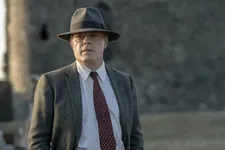 |
| Six Minutes To Midnight director Andy Goddard with Anne-Katrin Titze on Eddie Izzard and Bexhill-on-Sea: “Eddie used to go there as a child. I think it was a nice close to the circle to film there.” |
Earlier in our conversation, Andy Goddard mentioned John Boulting’s Brighton Rock (starring Richard Attenborough), Alberto Cavalcanti’s Went The Day Well?, and Robert Donat’s performance in Alfred Hitchcock’s The 39 Steps as references for his historical thriller Six Minutes To Midnight (co-written with Eddie Izzard and Celyn Jones). He also pointed out the innocence reflected in Lionel Jeffries’ The Railway Children and Peter Weir’s Dead Poets Society. Here the director notes the impact of the countryside of England, with its sunshine and long shadows, shot by Chris Seager, and the production design by Candida Otton.
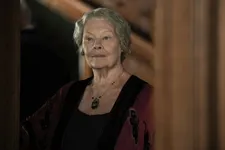 |
| Miss Rocholl (Judi Dench), headmistress of the Augusta-Victoria College Photo: courtesy of IFC Films |
The plot of Six Minutes To Midnight is unique and the title elegantly explains itself, while Thomas Miller (Eddie Izzard) embarks on his mission. From teacher to spy is only a short step and waking up sleeping giants of old can spill helpful landscape clues. Miss Rocholl (Judi Dench), headmistress of the Augusta-Victoria College, Bexhill-on-Sea, and her aide, the former Olympian swimmer Ilse Keller (Carla Juri) provide lessons to the group of girls from Germany during the summer of 1939.
From Manchester, Andy Goddard joined me on Zoom for an in-depth conversation on Six Minutes to Midnight.
Anne-Katrin Titze: The production design [Candida Otton] and the cinematography are great. Some of the imagery is very strong. When you have the girls do their exercises in those little white tank tops with the swastikas - there’s famous footage from propaganda films, which was for example used in Rüdiger Suchsland’s Hitler’s Hollywood.
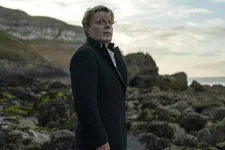 |
| Andy Goddard on Eddie Izzard (Thomas Miller): “It’s very close to Eddie’s heart and we filmed in Bexhill-on-Sea and Eastbourne on our last day.” Photo: courtesy of IFC Films |
AG: Yes. I know of it. And there’s those Leni Riefenstahl movies as well. That look obviously with the sunshine we had and the long shadows as well, it’s kind of very rigid and very structured and also very calculated, I guess. But at the same time, it’s coming back to the theme of innocence within that framework. It was sort of presenting the audience with what they think Nazism is and then kind of pulling the rug a bit, saying, yes, take this off their chest, they’re just girls. That’s what Eddie kept saying, they’re just innocent girls. It’s that thing, you take a young heart and you fill it with love or you fill it with hate. What you choose defines the person you are and defines the world you are trying to build. So the idea of a schoolteacher hero was really appealing to us.
AKT: The idea of innocence and being thrown into the summer of 1939 works really well. It could be the Mitford sisters.
AG: Yes, yes, yes.
AKT: A question about the Reuter statue on the desk - is that a MacGuffin? Is there a sculptor with that name? Did you invent him? If yes, how do you spell him?
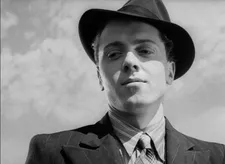 |
| Richard Attenborough in John Boulting’s Brighton Rock (1948) was a reference for Andy Goddard |
AG: We invented that. So it is a MacGuffin. Long time since we wrote the script. Reuters? It’s not like Reuters Reuters. That was just a fabrication.
AKT: Songs are very important in your film. That’s why I brought up Hitler’s Hollywood, which begins with the song you are using, the “Jawoll meine Herrn” song when they come down the stairs. It’s from a German Sherlock Holmes film from 1937.
AG: Yes, that’s right.
AKT: Then you use the Stars in Indiana song, which I have never heard, which is beautiful. The song that you use over the end credits seems like a big departure from the film. I was very surprised by that.
AG: The end credit one? With Al Bowlly, we wanted something very wistful and genteel and warmly romantic which is what the music of Al Bowlly is. And I needed that to counterpoint the violence that is happening within that sequence. Because it’s like a two-tiered scene - what’s going on downstairs with Judi and what’s going on upstairs with Eddie’s character. The idea was to counterpoint the tension with this beautiful kind of music. And “Jawoll meine Herrn” I kind of forgot where we sourced that but it was so appropriate in terms of what Judi’s character might play at the Anglo-German fellowship presentation. And the song in the end is sung by Sarah Townsend, who is Eddie’s producing partner. That’s just a full stop at the end of the film.
AKT: “Childhood is made up of a few summers.” That’s quite a quote. It’s at the core of the film, isn’t it?
AG: Yeah, Celyn Jones wrote that line. It’s a line that’s been picked up by quite a few people, as beautifully pitched by Jim Broadbent [as bus driver Charlie]. Again, I guess it’s the reminder of the innocence of youth in a time of impending war. And about the currency at stake. What Thomas Miller is fighting for. These girls. If you think about a childhood, that is x number of summers - that is childhood. And the idea that after this summer of 1939, for these girls there will be no more innocent summers. It’s going to be summers of war.
AKT: There will be no more innocence for the world.
AG: No, exactly. It’s a reminder of that’s what we were fighting for. It’s what we continue to fight for. These things have not gone away, they’re still with us. That’s what that line was all about. It felt right that it was that character who chooses to stand by Eddie. It’s a beautiful line. It feels like Walt Whitman or something. It’s very poetic.
AKT: Eddie spent part of her childhood in that place and knew about the boarding school, is that correct?
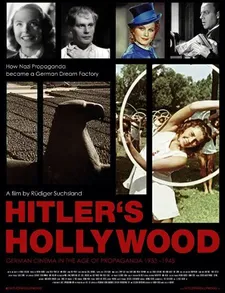 |
| Rüdiger Suchsland’s Hitler's Hollywood poster |
AG: Yeah, Eddie grew up in Bexhill-on-Sea and there was a museum there, Bexhill Museum and in the museum there is a school blazer badge. And this is where this whole journey began. On the badge there is a Union Jack and a Nazi swastika with the name of the school. This kind of lit a fire in Eddie’s head. What was this school? And Eddie talked to the people in the museum and they told him [her] about Augusta Victoria College for Girls. And this school that was teaching girls English and comportment lessons etc. Girls from rich families in Germany. And this being the mid- to late Thirties, a lot of those rich families were part of the National Socialist Party.
So you had these daughters of Nazis in England. And Eddie was fascinated that this was a nugget of truth in our British history and that’s how he [she] kind of started on this. He [she] knew he [she] wanted to tell a story about this school and what it was and maybe use it as a jumping off point to talk about the more meaningful stuff that we have just been talking about. So it’s very close to Eddie’s heart and we filmed in Bexhill-on-Sea and Eastbourne on our last day. When you see Eddie being chased across the shore by the police, when you see him [her] climbing on top of this cliff point, pinnacle point where he [she] looks out, Eddie used to go there as a child. I think it was a nice close to the circle to film there.
Read what Andy Goddard had to say on the films that influenced him, Carla Juri, costume designer Lucinda Wright, and Alfred Hitchcock’s The 39 Steps.
Six Minutes To Midnight opens in cinemas in the US and on the Internet in the UK on March 26.








